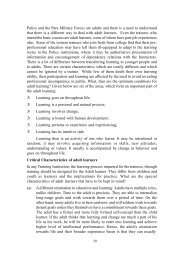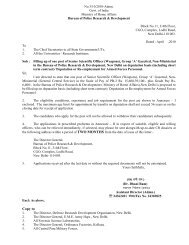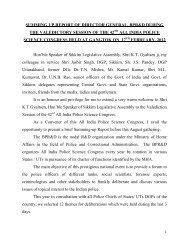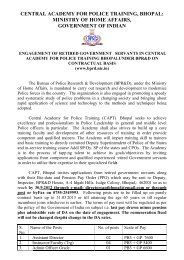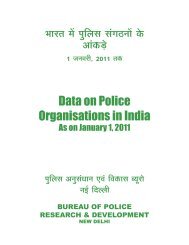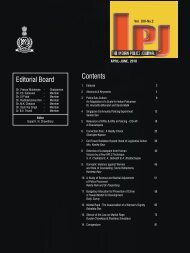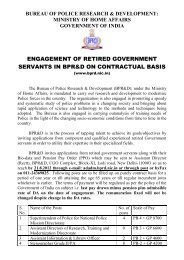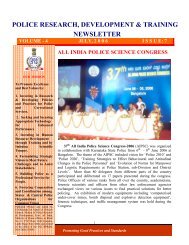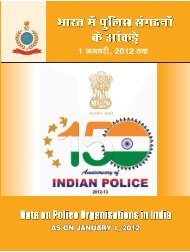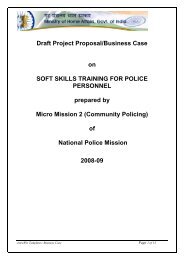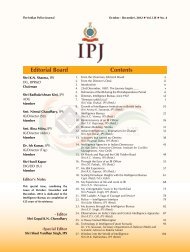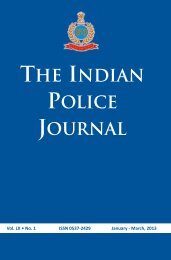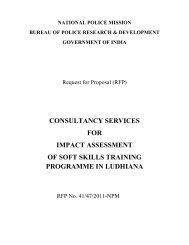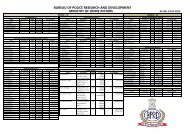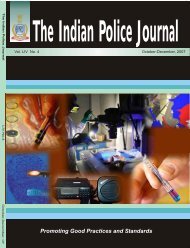SUPREME COURT & HIGHCOURT Rulings on POLICE
SUPREME COURT & HIGHCOURT Rulings on POLICE
SUPREME COURT & HIGHCOURT Rulings on POLICE
Create successful ePaper yourself
Turn your PDF publications into a flip-book with our unique Google optimized e-Paper software.
1.3 : I NTERROGA TIONBhagwan Singh vs State of P<strong>on</strong>jab*FactsHeldJoginder Singh, ASI and the other three accused namely, two Head C<strong>on</strong>stables and aC<strong>on</strong>stable were working in the C.I.A. Staff, Amritsar. On August 6,1978 at about 4.00p.m. they went to the Hotel of Virsa Singh, PW6 and brought Joginder Singh, deceasedal<strong>on</strong>gwith PWs 4, 5 and 6 to the C.LA Staff Room in Rambagh P.S. and interrogated.them about smuggled narcotic powder. In the CfJurse of interrogati<strong>on</strong>, ASI and the twoHead C<strong>on</strong>stables caused Injuries to the deceased with their weap<strong>on</strong>s till he becameunc<strong>on</strong>scious. PWs 4, 5 and 6 were kept outside under the guard of two. C<strong>on</strong>stableswhen the deceased was being interrogated and heaten in the room. Thereafter, PWs 4,5 and 6 were also taken inside the room and it is alleged that all the accused inflictedinjuries <strong>on</strong> them also while interrogating them about the smuggled powder. PWs 4, 5and 6 were then taken to C.I.A. main building and were detained there till August 9,1978. Later, they were dropped near a by-pass road. They went to the Hospital and gotthemselves medically treated by PWI, Civil Surge<strong>on</strong>, Amritsar. Further case ofprosecuti<strong>on</strong> is that the unc<strong>on</strong>scious deceased was taken in a car but he expired <strong>on</strong> theway and the dead body was thrown into a river and the same could not be recoveredduring investigati<strong>on</strong>. PW 8 went to the village of deceased and informed his wife. Shethen met the S.S.P. and gave a report to him. As per Punjab Police, Rules, S.P.Amritsar City took up the investigati<strong>on</strong> and recorded the statement of witnesses. Hevisited the scene of occurrence and found' the walls of interrogati<strong>on</strong> room stained withblood. After completi<strong>on</strong> of the investigati<strong>on</strong> a charge-sheet was filed. The trial Courtc<strong>on</strong>victed accused pers<strong>on</strong>s under Secti<strong>on</strong> 365 I.P.C. <strong>on</strong>ly. The High Court, however,took a different view. Accepting the evidence of PWs 4 to 10 particularly that of injuredwitnesses PWs 4 to 6. The High Court also reached the c<strong>on</strong>clusi<strong>on</strong> that when <strong>on</strong>ce it isproved that the injured witnesses al<strong>on</strong>g with the deceased were kidnapped. C<strong>on</strong>finedand beaten up and later if dead body was not to be traced the <strong>on</strong>ly inference that can bedrawn is that the accused also caused the death of the deceased. Against this judgmentthese criminal appeals.It may be a legitimate right of any police officer to interrogate or arrest any suspect <strong>on</strong>some credite material but such an arrest must bean accordance with law and theinterrogati<strong>on</strong> does not mean inflicting injuries. It should be in its true sense purposeful,nanely, to make the investigati<strong>on</strong> effective. Torturing a pers<strong>on</strong> and using third degreemethods are of medieval nature and they are barbaric and c<strong>on</strong>trary to law. The police*(1992) 3 SCC 249



